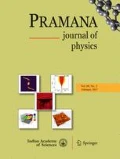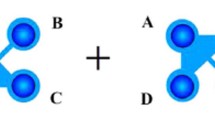Abstract
Quantum entanglement and its paradoxical properties are of paramount importance in quantum information theory. In recent years, there has been an increasing interest in the studies of high-dimensional quantum states and their impact on quantum communication as it can encode and process more data. Photonic entanglement is usually an evanescent property as it is destroyed easily by its interaction with an external environment. Electronic qubits are stable and can store information for a long time. However, qudit systems are more efficient, stable and allow noise robustness than qubit system. In this article, we investigate bipartite entanglement between doubly ionised molecular qudit and electronic qubit in the Auger emission process for \(\hbox {N}_{{2}}\) molecule following the absorption of a single photon without observing spin-orbit interaction (SOI). In the absence of SOI, Russell–Saunders coupling (L-S coupling) is applicable. The entanglement properties are estimated on the basis of negativity of partial transpose of the density matrix for Auger ionisation. We find that the entanglement depends on the spins of the singly ionised excited states and doubly ionised states of the molecules as well as on the directions of spin quantisation and of ejection of Auger electrons. A significant effect on the variation of negativity due to the linear dichroism (LD) has also been observed.




Similar content being viewed by others
References
J S Bell, Physics 1, 195 (1965)
M A Nielsen and I L Chuang, Quantum computation and quantum information (Cambridge University Press, Cambridge, England, 2010)
D Bouwmeester, A K Ekert and A Zeilinger, The physics of quantum information, quantum cryptography, quantum teleportation, quantum computation (Springer, Berlin, 2013)
G Alber, T Berth, M Horodecki, P Horodecki, R Horodecki, M Rötteler, H Weinfurter, R Werner and A Zeilinger, Quantum information: An introduction to basic theoretical concepts and experiments (Springer, Berlin, 2000)
A Peres, Phys. Rev. Lett. 77, 1413 (1996)
M Horodecki, P Horodecki and R Horodecki, Phys. Rev. A 223, 1 (1996)
M Horodecki, P Horodecki and R Horodecki, Phys. Rev. Lett. 80, 5239 (1998)
M Horodecki, P Horodecki and R Horodecki, Rev. Mod. Phys. 81, 865 (2009)
Xu Zong-Cheng, Liang Mai-Lin, ZhangYa-Ting and Yao Jian-Quan, Pramana – J. Phys. 86, 495 (2016)
Wei Deng and Yong Deng, Pramana – J. Phys. 91: 45 (2018)
N Chandra and R Ghosh, Quantum entanglement in electron optics (Springer-Verlag, Berlin, 2013)
Jianwei Wang et al, Science 360, 285 (2018)
Nurul T Islam, High-rate, high-dimensional quantum key distribution systems (Springer Nature, Switzerland, 2018)
Daniele Cozzolino, Beatrice Da Lio, Davide Bacco and Leif Katsuo Oxenløwe, Adv. Quantum Technol. 1900038, 1 (2019)
A Babazadeh, M Erhard, F Wang, M Malik, R Nouroozi, M Krenn and A Zeilinger, Phys. Rev. Lett. 119, 180510 (2017)
A Vaziri, J W Pan, T Jennewein, G Weihs and Zeilinger, Phys. Rev. Lett. 91, 227902 (2003)
Shu-Qian Shen, Jin-Min Liang, Ming Li, Juan Yu and Shao-Ming Fei, Phys. Rev. A 101, 012312 (2020)
Chee Kong Lee, Mojdeh S Najafabadi, Daniel Schumayer, Leong Chuan Kwek and David A W Hutchinson, Sci. Rep. 9, Article number: 9147 (2019)
S Parida and N Chandra, Phys. Rev. A 79, 062509 (2009)
M Chakraborty and S Sen, J. Electron. Spectrosc. Relat. Phenom. 203, 60 (2015)
M Chakraborty and S Sen, TMLAI 7, 1 (2019)
N Chandra and R Ghosh, Phys. Rev. A 74, 052329 (2006)
S Parida and N Chandra, Eur. Phys. J. D 65, 303 (2011)
S Lee, D P Chi, S D Oh and J Kim, Phys. Rev. A 41, 495301 (2008)
C H Bennett, D P DiVincenzo, J Smolin and W K Wootters, Phys. Rev. A 54, 3824 (1996)
G Breit and H A Bethe, Phys. Rev. 93, 88 (1954)
N Chandra and M Chakraborty, J. Chem. Phys. 97, 236 (1992)
A R Edmonds, Angular momentum in quantum mechanics (Princeton University Press, Princeton, 2016)
D A Varshalovich, A N Moskalev and V K Khersonskii, Quantum theory of angular momentum (World Scientific, Singapore, 1989)
A de-Shalit and I Talmi, Nuclear shell theory: Pure and applied physics, V14 (Literary Licensing, LLC, 2013)
D Stalherm, B Cleff, H Hillig and W Mehlhorn, Z Naturforsch. 24a, 1728 (1969)
F Martin, D A Horner, W Vanroose, T N Rescigno and C W McCurdy (Lawrence Barkley National Laboratory 2005), http://escholarship.org/uc/item/1kn7g7xc.
K Blum, Density matrix theory and applications 3rd edn (Springer-Verlag Berlin and Heidelberg GmbH & Co., 2012)
Author information
Authors and Affiliations
Corresponding author
Rights and permissions
About this article
Cite this article
Sen, S., Chakraborty, M. Bipartite entanglement in Auger ionisation of \({\text{ N }}_{2}\). Pramana - J Phys 94, 125 (2020). https://doi.org/10.1007/s12043-020-01989-8
Received:
Revised:
Accepted:
Published:
DOI: https://doi.org/10.1007/s12043-020-01989-8




